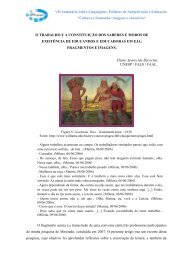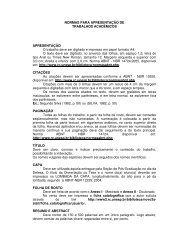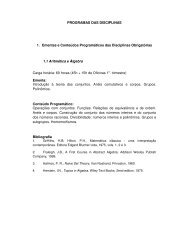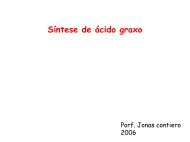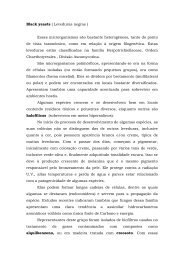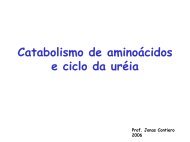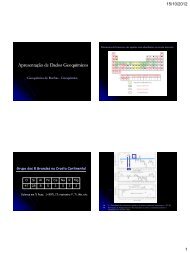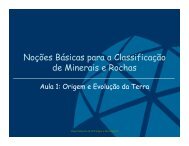Diet and Spatial Pattern of Foraging in Ectatomma opaciventre ...
Diet and Spatial Pattern of Foraging in Ectatomma opaciventre ...
Diet and Spatial Pattern of Foraging in Ectatomma opaciventre ...
Create successful ePaper yourself
Turn your PDF publications into a flip-book with our unique Google optimized e-Paper software.
T<strong>of</strong>olo, V.C. et al. — <strong>Spatial</strong> <strong>Pattern</strong> <strong>of</strong> <strong>Forag<strong>in</strong>g</strong> <strong>in</strong> E. <strong>opaciventre</strong><br />
Table 2 . Items collected by foragers <strong>of</strong> <strong>Ectatomma</strong> <strong>opaciventre</strong> <strong>in</strong> the<br />
field. The numbers <strong>in</strong> parentheses represent the relative abundance (%)<br />
<strong>of</strong> the items <strong>in</strong> each group.<br />
Prey Amount (%)<br />
Hymenoptera (55.56%)<br />
Ichneumonidae 1 (2.78)<br />
Formicidae (52.78%)<br />
(Ectatomm<strong>in</strong>ae) <strong>Ectatomma</strong> brunneum 1 (2.78)<br />
(Formic<strong>in</strong>ae) Camponotus rufipes 3 (8.33)<br />
(Dolichoder<strong>in</strong>ae) Conomyrma 5 (13.89)<br />
(Myrmic<strong>in</strong>ae) Pseudomyrmex 5 (13.89)<br />
(Myrmic<strong>in</strong>ae) Pheidole 5 (13.89)<br />
Lepidoptera (5.56%)<br />
Pyralidae 1 (2.78)<br />
Unidentified chrysalis 1 (2.78)<br />
Coleoptera (13.89%)<br />
Mycetophagidae 2 (5.56)<br />
Curculionidae 2 (5.56)<br />
Unidentified 1 (2.78)<br />
Araneae (2.78%)<br />
Salticidae 1 (2.78)<br />
Fragments (13.89%)<br />
Orthoptera 1 (2.78)<br />
Coleoptera 2 (5.56)<br />
Formicidae 2 (5.56)<br />
Grass seeds (8.33%) 3 (8.33)<br />
<strong>and</strong> other <strong>in</strong>vertebrates, liv<strong>in</strong>g or dead, were collected. Some <strong>of</strong> them were<br />
large <strong>and</strong> highly aggressive. Ants, especially Gnamptogenys, Odontomachus,<br />
Pheidole, Azteca, <strong>and</strong> Camponotus, were an important part <strong>of</strong> this diet (Pie<br />
2004; Pratt 1989). The same pattern was reported <strong>in</strong> a study by Giannotti <strong>and</strong><br />
Machado (1992). They recorded 20 types <strong>of</strong> food <strong>of</strong> animal orig<strong>in</strong> (<strong>in</strong>sects<br />
<strong>and</strong> <strong>in</strong>vertebrates) <strong>and</strong> several others <strong>of</strong> vegetal orig<strong>in</strong> (like seeds, pulp, leaves,<br />
613




